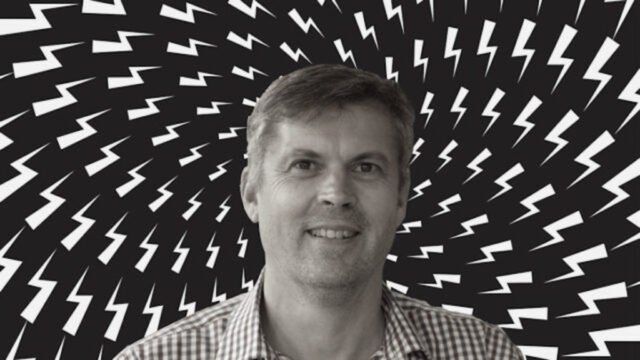In this dubious era of online influencers, winning (or buying) the endorsement from a Kardashian or similar can be worth millions in sales if you’re selling – say – cosmetics or Uber Eats.
But how about the seal of approval from the POTUS himself?
The newly-listed Curvebeam AI can claim US President Joe Biden’s advocacy of its weight-based computed tomography (WBCT) device, to monitor orthopaedics and bone health conditions.
The leader of the free world underwent WBCT to monitor healing progression of a hairline fracture in his foot, sustained while playing with his dogs.
The procedure, at Pennsylvania University, was carried out with one of Curvebeam’s earlier devices – the Pedcat – in 2020.
Initial x-rays were clean, but a follow-up computed tomography (CT) scan confirmed a small hairline fracture in his foot.
The fracture meant POTUS had to wear a moon boot, prompting conspiracy theorists to claim he was concealing an ankle bracelet – something to do with a Donald Trump inspired crackdown on a Democrat child sex ring.
Only in America! (Mind you, the prospect of having a convicted criminal in the White House isn’t that fanciful.)
About Curvebeam
Curvebeam is Melbourne-based but its operational nerve centre is in Hadfield, Pennsylvania.
Curvebeam AI (artificial intelligence) evolved in April last year from a merger between Straxcorp, a Melbourne University spin-off and the US-based Curve Beam LLC.
“It made so much sense to come together,” CEO Greg Brown says. “We were licencing each other’s platforms and had royalties going back and forth.”
The new Curvebeam listed on the ASX on August 24, having raised $25 million at 48 cents per share.
Curvebeam’s devices are based on cone-beam CT imaging, which can generate high-resolution, three-dimensional images of bones, soft tissue and dental structures.
“I can show you hundreds of CT scans covering foot, knee and ankle and hip where the CT looks fine, but when you see a weight-bearing stance you know exactly what’s going on,” Mr Brown says.
Overlaid on that, artificial intelligence (AI) modalities create high-quality CT images. For example, the granular assessment of a patient’s bone mineral density (BMD) could help to appraise the risk of a fracture.
“This is a world’s first in deep-learning AI and it is all from Melbourne,” Mr Brown says.
About 60 percent of patients presenting for a partial or total joint restoration will have an undiagnosed problem.
“Nothing annoys a surgeon more than a beautifully fitted joint, but then [finding] a fracture in the bone,” he says.
“One of the highest risk factors for total joint replacement is this undiagnosed, untreated fragility.”
Inspired by a real BBQ stopper
A medical scientist, Mr Brown has a personal motive for joining Curvebeam: 10 years ago, his mother had an “unremarkable fall” at a family barbeque. A bone mineral density (BMD) test failed to pick up any fracture.
“She was sent home with no therapy but went on to have a second fracture, which could have been prevented if they had picked up this fragility,” he says.
At the time, Mr Brown was CEO of the ASX-listed Impedimed. Before then he had offshore roles at Baxter Diagnostics, Roche Molecular and Digne Corp.
Major shareholder Arun Singh founded Curvebeam LLC, where he developed the first commercial cone-CT imaging system, for dental and maxillofacial uses.
Currently he is also Curvebeam’s chief operating officer, chief technology officer and US head,
Curvebeam has 50 employees here and in the US, with 18 regional distributors.
In the US, Curvebeam has a distribution and co-marketing compact with the New York listed Stryker Corp, enabling access to 500 Stryker sales reps and 40 regional specialists.
Heads, shoulders, knees and toes …
Curvebeam’s first-generation device – the POTUS-approved Pedcat – was for foot and ankle scanning only. A second product called Lineup added knees to the repertoire.
The key benefits of Hirise, the company’s flagship product, is that the procedure is quicker and easier than traditional CT or magnetic resonance imaging (MRI) scans, taking one to three minutes.
Because they are in their natural pose, patients are more comfortable and are subject to 66 percent less radiation than with CTs.
To date, 170 Hirise units have been placed, 132 of them in the US. Early adopters include the University of California Los Angeles, the Mayo Clinic, Duke Orthopaedics and the New York Hospital for Special Surgery.
Six are in use in Australia.
Hirise has also been placed in 43 orthopaedic practices in the US and Europe.
Then there’s Inreach HR-PQCT – as in high-resolution peripheral quantitative CT – a wrist scanner for bone microstructural assessment: “the first product capable of natural bilateral WBCT from hip to foot”.
The thesis here is that traditional bone fragility detection is based on measuring bone mineral density (BMD), but 80 percent of women with a fragility fracture had normal BMD measurements.
The current method of assessing BMD is via a DEXA machine, which has low energy x-rays that only measure the surface density of the bone.
Hirise and Inreach HR-PQCT have been approved by the US Food and Drug Administration, the Australian Therapeutic Goods Administration and have Conformité Européenne (CE) mark.
Reach for the sky …
Curvebeam is also developing Skyrise, a platform that scans the neck, shoulder and spine right through to the foot. About 20 percent of the IPO funds raised are earmarked for developing this product.
Mr Brown says accurate soft and hard tissue measurements are crucial to treat back and shoulder disorders.
The company expects to complete product testing in financial year 2025, with a launch, assuming regulatory clearance, in financial year 2026.
AI products
Curvebeam’s key AI products are Cubevue Autometrics (advanced visualisation tools, BMD and Ossview (bone fragility software).
A French clinical trial covering 2,000 women over eight months showed that Ossview predicted 70 percent of fractures, while the standard-of-care predicted a mere 30 percent.
A BMD AI module is targeted for FDA submission by July 2024, using the predicate device approval route, with US commercialisation slated by mid-2025.
The idea is that surgeons don’t have to send a patient elsewhere for a BMD test, which can result in them getting ‘lost’ for months. The tests can be done in the clinics and the clinics get reimbursed.
“BMD is indicated for most people having a joint replacement, yet published figures show only 15 percent are getting [a BMD scan],” Mr Brown says.
Ossview has FDA breakthrough device designation, but the company expects the BMD device to deliver 95 percent of AI revenues.
Addressable market
Curvebeam estimates the size of the point-of-care CT imaging sector at $10 billion and the bone health and fracture protection at a further $4.1 billion.
The latter could be an addressable market of $1.4 billion for Ossview scan revenue and $2.7 billion for BMD analysis.
The CT imaging market is roughly equally divided between orthopaedic surgeons, imaging chains and hospitals.
In the US, Hirise is reimbursed at an average Medicare rate of $US138.77 per scan.
At a cost of $US410,000 per device, a clinic could recoup its investment in just under 18 months, or five years under a lease financing model.
With the AI modules, Curvebeam estimates revenue of $A150,000 to $A200,000 per device per annum (based on an average five BMD tests per day).
“So, for every 100 Hirises we place, that is $15 million to $20 million of revenue and this annuity income builds over time,” Mr Brown says.
He adds that the clinics should be happy too, as they are reimbursed for their BMD tests and will have fewer revision surgeries to contend with.
Curvebeam also expects to be reimbursed in Germany, where it has created a subsidiary company in readiness.
Finances and performance
Curvebeam’s proforma revenue of $11.48 million in the 2022-’23 year derived from only 16 initial Hirise devices and three sales reps.
“We are now rolling out the Stryker relationship with 500 [sales representatives] on the ground, so we hope to build this footprint very quickly,” Mr Brown says.
The IPO raised $25 million at 48 cents apiece, implying a day-one valuation of $153 million.
To date, the company has raised $85 million.
The company expects about 80 percent of sales to come from the US market, with most of the rest emanating from Europe.
In the main, the IPO proceeds have been earmarked for sales and marketing ($11.3 million), research and development ($4.1 million) and working capital ($4.4 million).
Curvebeam shares debuted well under par, trading between 33 cents and 37 cents on IPO day, but briefly hit 54 cents this week after fund manager Perennial outed itself as a major holder.
Along the way the company has raised $85 million, helped by a strong rota of investors including mining barons Brian Flannery and Andrew Forrest.
Curvebeam share price charts
Scanning the rivals
According to the prospectus, rivals include key bone imaging products in x-ray and upright CT.
Competing offerings include the EOS Biplanar full body x-ray, Siemens’ Multitom Rax Twin robotic x-ray and the Planmed Verity CT.
“The rivals are ‘unilateral’,” Mr Brown says. “The [patient’s] weight is on one limb and is not naturally weight bearing.
“Other products have limitations in terms of patient positioning.”
The company says it is “not aware of any other company that has developed, or is developing, AI-driven software aids for BMD assessment and complete bone microstructure risk.”
So there!
Dr Boreham’s diagnosis:
The way to look at Curvebeam is that its first-to-market hardware provides the ‘steak’ while the AI overlays provide the sizzle.
Given the broader investor hype about artificial intelligence, Curvebeam’s ASX debut has been somewhat undercooked.
Mr Brown feels the pain, having invested $6.1 million in the company along the way and pouring $750,000 into the IPO. So too does Mr Singh, who has invested $15 million.
“I love this company,” Mr Brown says.
“By putting my money where my mouth is I am showing investors not to take any risks that I would not be taking.”
Unlike most start-up device plays, Curvebeam distinguishes itself by generating significant revenue even without the annuity AI streams.
The patient need clearly exists: musculoskeletal disorders affect about 1.7 billion people worldwide, 700 million of whom have osteoporosis or osteoarthritis.
Curvebeam chair Robert Lilley opines: “The consequences of undiagnosed bone frugality, in particular, can be severe, both in the general ageing population and in total joint replacement patients.”
As usual, the challenge is to convince clinicians to adopt the best techniques and equipment, rather than the ones they are simply used to.
Disclosure: Dr Boreham is not a qualified medical practitioner and does not possess a doctorate of any sort. He would put his money where his mouth is, if he was a genuine on-line influencer, but is yet to create an Instagram account.
This column first appeared in Biotech Daily
You might be interested in












